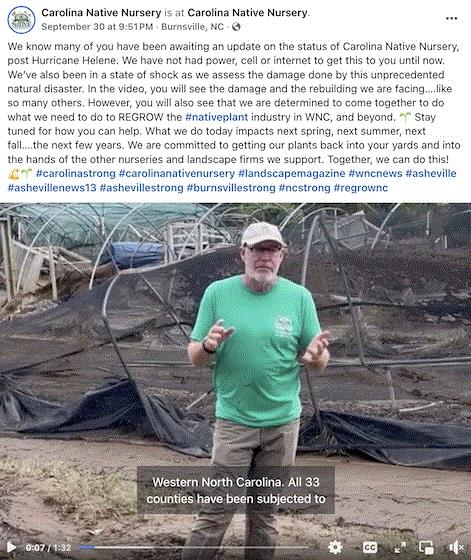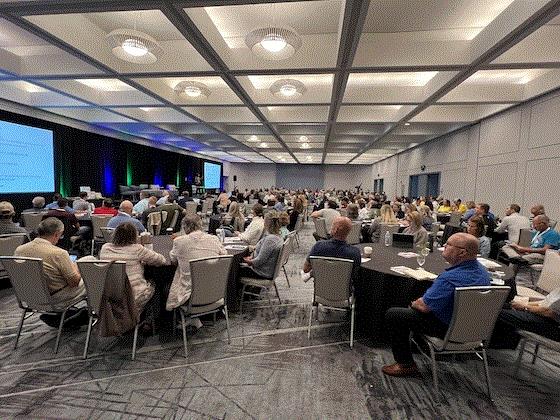Relief for Helene
Hurricane Helene and the rains that preceded its move through Florida, Georgia, Tennessee and the Carolinas was a “take notice” warning that today’s storms are different. They are larger and many hit in regions that have little previous historical occurrence. Storms that come in XXXL sizes like Helene clear the table and make everyone equally helpless. I am sure there are dozens of affected horticulture operations impacted by Helene. One that was brought to my attention is wholesale nursery Carolina Native Nursery, which is closed until further notice. The company’s Facebook page reveals just some of the storm’s impact on the business, and indicates the extent to which the destruction of their business will impact landscape plant availability throughout the region—for years to come.

If you’re in the impacted regions and you’re reading this now, I’m so very glad you made it through. Your operation or your store may be in splinters, but you’re still kicking. All else can be replaced in some way. Doesn’t seem like it can be, but life has its ways.
Some of those ways are quite bureaucratic and pedestrian. The Small Business Administration has disaster loans available for impacted counties within these states (clink on the state to see if your county is listed):
Several types of disaster loans are available. These include:
-
Business Physical Disaster Loans: Loans to repair or replace disaster-damaged property owned by the business, including real estate, inventories, supplies, machinery and equipment. Businesses of any size are eligible. Private, non-profit organizations are also eligible.
-
Economic Injury Disaster Loans (EIDL): Working capital loans to help small businesses, small agricultural cooperatives, small businesses engaged in aquaculture, and most private, non-profit organizations of all sizes meet their ordinary and necessary financial obligations that cannot be met as a direct result of the disaster. These loans are intended to assist through the disaster recovery period.
-
Home Disaster Loans: Loans to homeowners or renters to repair or replace disaster-damaged real estate and personal property, including automobiles.
If you think any of these apply to you, apply online for a disaster loan. You can also call 800‐659‐2955 or schedule an in-person appointment if you have any questions.

AmericanHort’s List of Relief Resources
As I was typing the above section yesterday, an email from AmericanHort dropped into my inbox listing an extensive aggregation of resources for those emerging from Helene’s devastation. They’ve included some resources you may not have thought about, such as the USDA Emergency Forest Restoration Program (EFRP). They’ve also listed all the nursery and landscape associations for the affected state. Head over HERE for those names and contacts and the full list of resource suggestions AmericanHort gathered.
Included on this resource page is a list of tips for what to do after a storm. And may I remind you, this is applicable for any storm. The tips include:
-
Photograph and document damage before you start any clean-up efforts.
-
Authorities have likely already identified road obstructions, utility outages and hazardous situations. Continue to watch for such obstructions and notify local authorities if needed.
-
If you haven’t already, secure your structures and buildings and make any necessary repairs to prevent further weather intrusion and to ensure the safety of you and anyone in the area.
-
If needed, reach out to disaster assistance agencies to inform them of your situation. If you have crop insurance, you may be eligible for disaster relief or low-interest loans. Be sure to contact the relevant agency for guidance on how to proceed.
-
Contact your county/local USDA Farm Service Agency (FSA) office.
-
Contact your state horticultural association or Department of Agriculture for assistance.
-
Contact AmericanHort with any questions or requests for assistance.
Print this out, as well as the list of federal and state agencies. And don’t just save it to your computer—those links won’t do you much good if you don’t have electricity and cell/internet service.
Thank you, AmericanHort, for developing and sharing this resource. Invaluable for now and for the future!

Speaking of AmericanHort
The GrowerTalks/Green Profit/AmericanHort Salary & Benefits Survey closes this Friday, October 4. The survey is how you can better understand salary and benefit trends and how you compare to your survey-taking peers. The survey includes company demographics, staffing and benefits, and salary data on dozens of different job titles across full-time, part-time and seasonal employees.

CLICK HERE to fill out the survey. You do not need to be a member of AmericanHort to benefit from it. All survey respondents will get the full report prepared by Industry Insights. AmericanHort Premium member respondents will receive the Comparison Report at no cost. (Not an AmericanHort member? Find out how to become one HERE). Oh, and you can also enter to win a Yeti 45 cooler. How “cool” is that?
Poorly Timed Port Strike
With storm devastation and election clips dominating the headlines, please do not miss the news about the dockworkers strike that began October 1. It’s impacting 36 ports along the East and Gulf coasts. These ports and the people who work them handle upwards of half of all U.S. trade volumes. The strike had been threatened for months.

The shipping and port industries have had a tough handful of years. First, covid disrupted shipping schedules, then the ports became overwhelmed. The Dali wreck in the Port of Baltimore upended receivables (as well as traffic) this summer. Now this longshoremen’s strike, which could throw a major wrench into holiday sales should it continue for more than a few weeks.
Keen operations managers have been paying attention and stocking up on staples and popular retail items. I’m curious, have you been aware of the impending strike? Did you take precautions? How long will you be able to hold out until it starts impacting your operation? I’d love your thoughts on this—send them to me HERE.

MANTS
Speaking of Baltimore, registration for MANTS 2025 is now open. Widely considered as “opening day” for the horticultural trade show season, MANTS will take place at the Baltimore Convention Center January 8-10.
The show has become a must-visit over the last decade, and certainly since I’ve started writing this newsletter. It routinely attracts more than 11,000 visitors and 900 exhibitors, and I believe the exhibition space was sold out last year. I attended last year for the first time in a while, and it was a hopping place even on the last day. Its reputation as a nursery-heavy show lingers, but it’s become much more than nursery. In fact, I found lots of great retail products, and I wrote about a few of them HERE. Whether retail or nursery products, attendees are there to do business as it’s an order-writing show. In fact, the MANTS tagline is “MANTS means business.”

Early bird pricing at $20 per person is available through December 6, and then it ticks up to $30 per person. Also, they’ve changed their hours for the third and last day of the show—it is now 8 a.m. to 1 p.m.
Access the special hotel rates HERE until January 3. All eight of these hotels are within walking distance of the convention center, which is important in frigid January. And maybe you’ll even be treated to an opportunity to attend a Ravens post-season game that weekend, as they are looking really good this year. For more information and to register for MANTS 2025, visit the MANTS website.

Gathering to Learn
Colleague Jen Polanz attended this year’s Fall Event for The Garden Center Group last week. Here’s the first of a few reports she’s including in buZZover the next few weeks.
Every year I go to The Garden Center Group Fall Event (this year in Dallas) I get so much out of it—from seeing old friends to meeting new friends and learning so much from everyone. I have to give credit to Danny and Karen Summers for coordinating a wonderful event every year, complete with dynamic speakers, a well-thought-out tour and opportunities for retailers to connect with suppliers and each other. Everyone hits the ground ready to learn and share.

A gaggle of garden center folks are eager and ready to better their businesses at one of The Garden Center Group’s Fall Event seminars.
So, what did I learn? As Ellen shared last week, the main concern is lack of foot traffic across many of the regions of North America that the group serves. As consultant Sid Raisch noted at last year’s event, we are seeing a reduction in Baby Boomer customers, and now the main focus needs to be converting our customer base to younger generations. Gen X (hi, that’s me) is too small to replace the Boomer customers fully, so think Millennials and Gen Z (yes, they’re plenty old enough now to be a customer base).

But!
(continued from above)
BUT, as consultant Tim Quebedeaux said, just because your revenue is down doesn’t mean your profit has to be down. Sure, it’s harder, but not impossible to keep your profit dollars steady. Normally Tim has a panel with the “Best of the Best” – the top 10 garden centers. This year, however, he switched it up a bit and had the top garden center in each of the main categories sit on the panel.
Here are a couple of tips from those retailers, the top center in each of the main categories:
-
Watch the inventory that produces the bottom 10% of your margin dollars via your POS—consider whether you want to carry those.
-
Watch the buying—one retailer only buys what they need for some of the season, then goes back for more. They don’t mind scrambling a bit trying to find sources just to avoid getting stuck with product.
-
Some retailers were situated near universities—this is an untapped market with new customers every year. Consider how you can market to them.
-
Have more than one person looking at the numbers, and consider sharing them with managers so they can better understand where labor fits in.
-
If you do a lot of volume in a hardgoods category like soil, mulch or fertilizer, consider private labeling or white labeling.
A final thought from Sid: Don’t be boring. Right now, we are more about selling sizes of plants than creating excitement around the plants themselves. What will it take to make your store “fan”-worthy, as in, make your customers your biggest fans?
I’ll be highlighting the garden centers we visited over the next several issues of buZZ, so stay tuned for my reports from the road!
Oh! Before I forget, next year’s Fall Event will be in Raleigh, North Carolina, September 22-25.








Questions, comments, suggestions? Drop me a line if you'd like at ewells@ballpublishing.com.

Ellen Wells
Senior Editor
Green Profit
This week's BuZZ! was sent to 27,617 loyal readers!
If you're interested in advertising on BuZZ! contact Kim Brown ASAP!